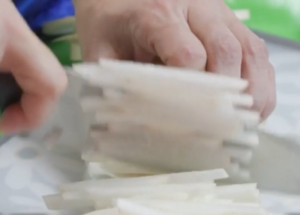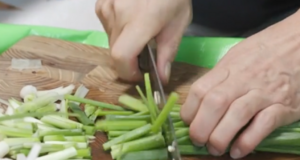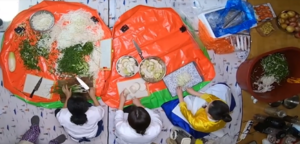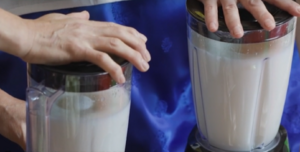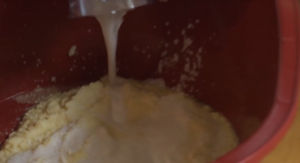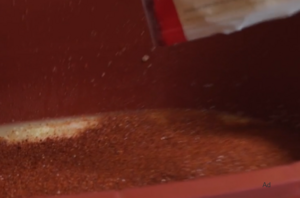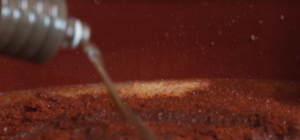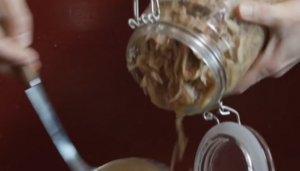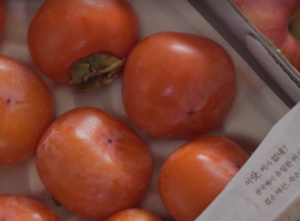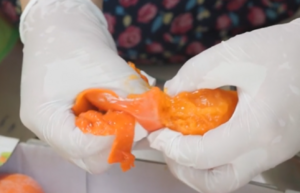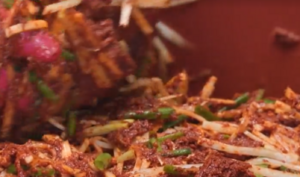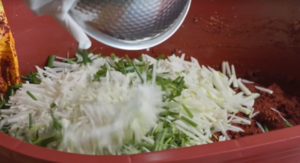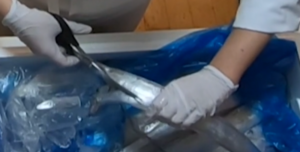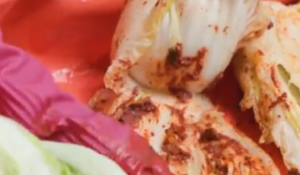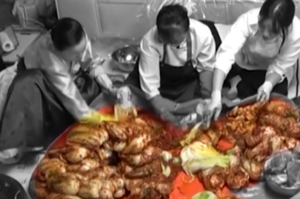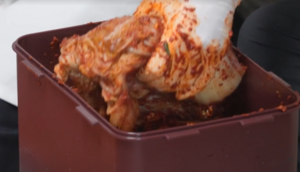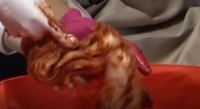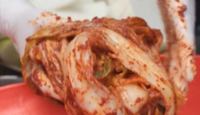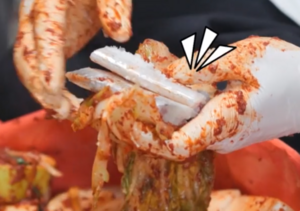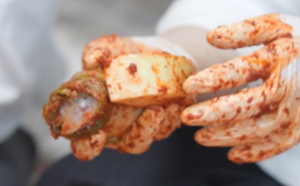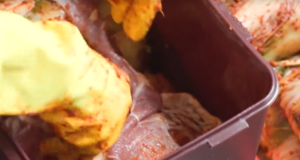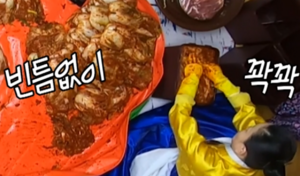Kimchi: Difference between revisions
mNo edit summary |
|||
| (6 intermediate revisions by the same user not shown) | |||
| Line 1: | Line 1: | ||
This is kimchi recipe as featured from a TV program Miun-uri-seki that was aired on 2024-11-25. Three experienced Korean traditional dish chefs (Yi Mi-young 이미영, Kim Mi-ryung 김미령, Jo Seo-hyung 조서형) shared their recipes. This is unique in that it brings multiple, regional recipes together into one (i.e. use of pork, fish, and methodologies.)<br/> [[File:ClipCapIt-241125-102852.PNG|300px]] | |||
== Ingredients == | == Ingredients == | ||
* Water | * Sticky rice liquid (찹쌀풀) | ||
* Cooked white rice (leftover rice is fine) | ** Water | ||
** Cooked white rice (leftover rice is fine) | |||
* Cabbage | * Cabbage | ||
* Radish, mostly cut sliced long and thin (3 inches and 3 mm thick), and leave some whole for making them into blocks later during storage<br/> [[File:ClipCapIt-241125-101804.PNG|300px]] | * Radish, mostly cut sliced long and thin (3 inches and 3 mm thick), and leave some whole for making them into blocks later during storage<br/> [[File:ClipCapIt-241125-101804.PNG|300px]] | ||
| Line 31: | Line 34: | ||
##* Cut off head diagonally from the back of the head and diagonally down<br/>[[File:ClipCapIt-241125-102524.PNG|300px]] | ##* Cut off head diagonally from the back of the head and diagonally down<br/>[[File:ClipCapIt-241125-102524.PNG|300px]] | ||
##* Scrape out organs | ##* Scrape out organs | ||
## Cut to about height | ## Cut to roughly about height and width ratio of 2:3 inch blocks | ||
# Scrape in kimchi sauce between cabbage leaves (from inside to out)<br/> [[File:ClipCapIt-241125-102616.PNG|300px]] | # Scrape in kimchi sauce between cabbage leaves (from inside to out)<br/> [[File:ClipCapIt-241125-102616.PNG|300px]] | ||
#* Don't stuff it with sauce, but lightly scrape it in equally | #* Don't stuff it with sauce, but lightly scrape it in equally | ||
# Store | # Store<br/> [[File:ClipCapIt-241125-103610.PNG|300px]] [[File:ClipCapIt-241125-104136.PNG|300px]] | ||
## Fold from the loose end with two flaps hanging to the side | ## Fold from the loose end with two flaps hanging to the side<br/> [[File:ClipCapIt-241125-103328.PNG|200px]] | ||
## Use the remaining flaps to wrap around the fold | ## Use the remaining flaps to wrap around the fold<br/>[[File:ClipCapIt-241125-103344.PNG|200px]] [[File:ClipCapIt-241125-103407.PNG|200px]] | ||
## Take a few green leaves and wrap about two blocks of fish and put in between prepared cabbages | ## Take a few green leaves and wrap about two blocks of fish and put in between prepared cabbages<br/> [[File:ClipCapIt-241125-103653.PNG|300px]] | ||
##* Note: adding more fish will dilute the saltiness, due to its water content | ##* Note: adding more fish will dilute the saltiness, due to its water content | ||
##* Fish will need to be fermented more than 3 months before eating | ##* Fish will need to be fermented more than 3 months before eating | ||
## Add cuts of radish to the side as a means to adjust saltiness (water from radish will further dilute) | ## Add cuts of radish to the side as a means to adjust saltiness (water from radish will further dilute)<br/> [[File:ClipCapIt-241125-103732.PNG|300px]] | ||
## Spread out slices of front hock in between layers of cabbages in the container | ## Spread out slices of front hock in between layers of cabbages in the container<br/> [[File:ClipCapIt-241125-103851.PNG|300px]] | ||
##* Kimchi gains a "cool" taste ("전지가 들어가면 시원해 짐") as it ferments according to an expert | ##* Kimchi gains a "cool" taste ("전지가 들어가면 시원해 짐") as it ferments according to an expert | ||
## Fill out the gaps on the top with loose (seasoned) leaves | ## Fill out the gaps on the top with loose (seasoned) leaves<br/> [[File:ClipCapIt-241125-103954.PNG|300px]] | ||
Latest revision as of 17:56, 25 November 2024
This is kimchi recipe as featured from a TV program Miun-uri-seki that was aired on 2024-11-25. Three experienced Korean traditional dish chefs (Yi Mi-young 이미영, Kim Mi-ryung 김미령, Jo Seo-hyung 조서형) shared their recipes. This is unique in that it brings multiple, regional recipes together into one (i.e. use of pork, fish, and methodologies.)
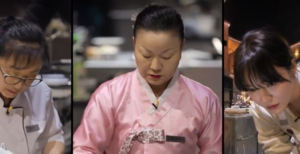
Ingredients
- Sticky rice liquid (찹쌀풀)
- Water
- Cooked white rice (leftover rice is fine)
- Cabbage
- Radish, mostly cut sliced long and thin (3 inches and 3 mm thick), and leave some whole for making them into blocks later during storage
- Garlic
- Korean chili powder
- Minced apple and Asian pear (alternatively, ripe peeled persimmons without seeds) -- used instead of sugar
- Salted shrimp (젓갈)
- Salted fish sauce (진젓)
- Green chives (쪽파), cut to about an inch
- Hairtail (aka cutlassfish)
- Slices of front hock (pork)
- Containers for storage
Direction
- Prepare cabbages
- Wash thoroughly
- Make kimchi sauce
- Pour minced garlic into a container
- Grind cooked white rice with water (instead of sticky rice liquid, called 찹쌀풀 in Korean) and pour it into the container
- Pour chili powder
- Put salted fish sauce
- Put fermented salted shrimp
- Put minced apple/pear or permissions
- Mix well
- Mix in sliced radish and chives
- Prepare fish and
- Cut to roughly about height and width ratio of 2:3 inch blocks
- Scrape in kimchi sauce between cabbage leaves (from inside to out)
- Don't stuff it with sauce, but lightly scrape it in equally
- Store
- Fold from the loose end with two flaps hanging to the side
- Use the remaining flaps to wrap around the fold
- Take a few green leaves and wrap about two blocks of fish and put in between prepared cabbages
- Note: adding more fish will dilute the saltiness, due to its water content
- Fish will need to be fermented more than 3 months before eating
- Add cuts of radish to the side as a means to adjust saltiness (water from radish will further dilute)
- Spread out slices of front hock in between layers of cabbages in the container
- Kimchi gains a "cool" taste ("전지가 들어가면 시원해 짐") as it ferments according to an expert
- Fill out the gaps on the top with loose (seasoned) leaves
- Fold from the loose end with two flaps hanging to the side
